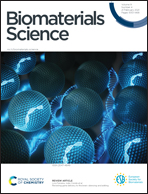The increased oxygen content in tantalum leads to decreased bioactivity and osteogenic ability of tantalum implants†
Abstract
Tantalum (Ta) implants fabricated by current processing techniques inevitably contain more or less oxygen impurities due to the extremely high melting point and high affinity of oxygen for Ta. Therefore, in this study we investigated whether oxygen impurities cause any effects on the bioactivity of Ta. EDS analysis demonstrated the surface oxygen content difference among different fabricated Ta samples, and the surface water contact angle (WCA) of Ta with high oxygen content (HO-Ta) was significantly higher than that of Ta with medium (MO-Ta) and low (LO-Ta) oxygen content. The in vitro cellular experiments showed that MC3T3-E1 cells on Ta with lower oxygen content exhibited better adhesion, growth, morphological development and in vitro osteogenic ability. Similarly, the in vivo animal experiments indicated the better bone regeneration and ingrowth performances of Ta with lower oxygen content. In addition, the highest ROS production was detected in the HO-Ta group, while the lowest in the LO-Ta group. This study suggests that the oxygen content within Ta, which occurs unavoidably due to technical limitations, negatively affects the bioactivity of Ta in a dose-dependent manner, indicating the need to develop techniques to produce orthopedic all-Ta implants.



 Please wait while we load your content...
Please wait while we load your content...